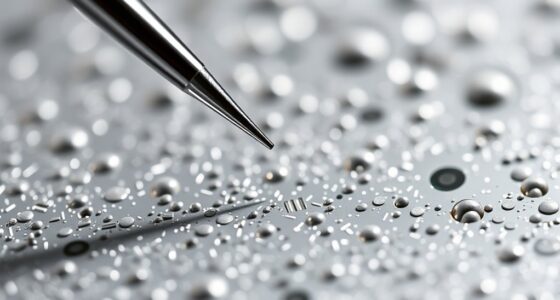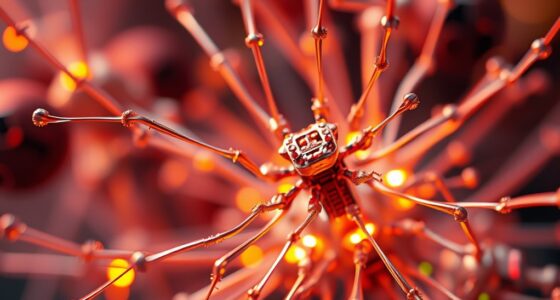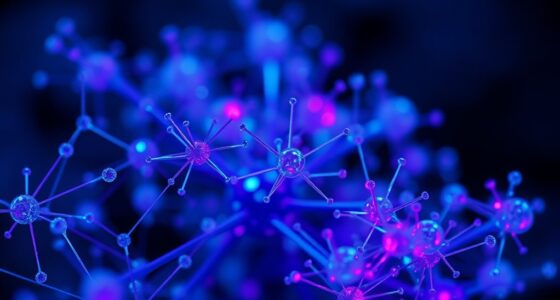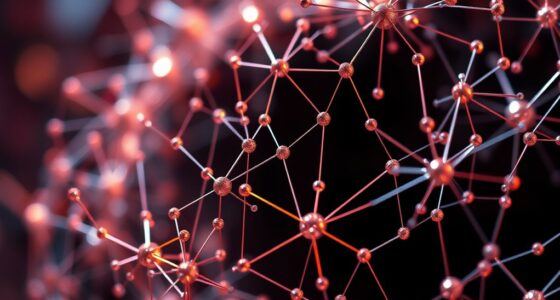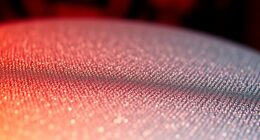Nanomachines operate at an atomic scale, just a few molecules thick, while micromachines work at micrometer to millimeter sizes. This size difference impacts their capabilities: nanomachines excel at molecular control but face limitations in strength and durability, whereas micromachines handle larger tasks with more robustness. If you explore further, you’ll learn how these scale differences shape their fabrication, uses, and future potential across various fields.
Key Takeaways
- Nanomachines operate at atomic scales (<100 nm), while micromachines function at micrometer to millimeter sizes.
- Fabrication of nanomachines relies on self-assembly and molecular techniques; micromachines use lithography and mechanical assembly.
- Nanomachines excel in atomic-level control but have limited mechanical strength; micromachines handle larger loads and broader tasks.
- Nanomachines are ideal for targeted medical applications and molecular sensing; micromachines are used in manufacturing and precise manipulation.
- Future advances focus on integrating AI, improving scalability, and addressing safety, with nanomachines enabling ultra-fine, molecular-level functions.
Defining Nanomachines and Micromachines
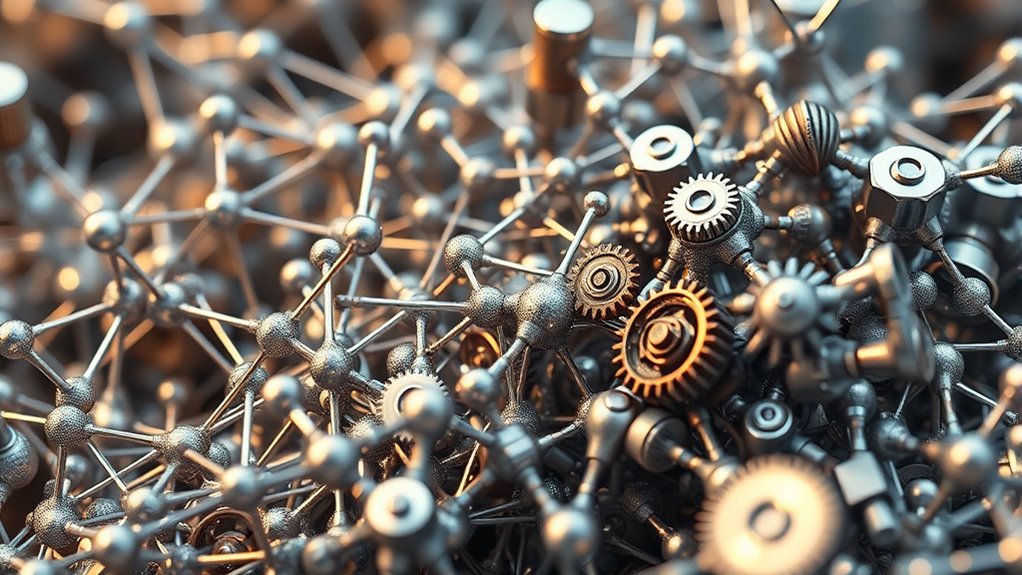
Nanomachines and micromachines are tiny devices designed to perform specific tasks at very small scales. Nanomachines typically operate at the nanometer level, often involving structures just a few atoms or molecules thick. They are engineered to manipulate molecules, deliver drugs, or repair materials at a microscopic scale. Micromachines, on the other hand, are larger, functioning at the micrometer level—thousandths of a millimeter. They are more like miniature robots capable of performing mechanical tasks such as moving small objects or assembling tiny components. Both types rely on advanced manufacturing techniques to create precise, functional devices. While they share the goal of miniaturization, their size differences influence their design, applications, and capabilities, setting the stage for more detailed comparisons. Additionally, the manufacturing processes for these devices are highly sophisticated, requiring cutting-edge technology to achieve the necessary precision and functionality.
Scale and Size Differences

While nanomachines and micromachines both operate at incredibly small scales, their size differences are fundamental to their design and function. Nanomachines are typically less than 100 nanometers, often comparable to molecules, enabling them to interact at the atomic level. Micromachines range from a few micrometers to millimeters, making them larger but still tiny compared to conventional machinery. These size variations influence their capabilities, such as mobility, precision, and energy requirements. Nanomachines excel in tasks requiring molecular interactions, while micromachines can handle more substantial loads and broader applications. The scale gap dictates not just their physical dimensions but also their potential uses and limitations. Material properties change markedly at these scales. Surface area-to-volume ratios increase dramatically. Power sources and energy efficiency differ markedly. Mechanical strength and flexibility vary with size.
Fabrication Techniques and Challenges

You need precise assembly methods to build nanomachines and micromachines, but achieving accuracy at such small scales is challenging. Handling materials without contamination or damage becomes increasingly difficult as size decreases. Overcoming these fabrication hurdles is essential to guarantee reliable performance and functionality. Additionally, maintaining material integrity during manufacturing is critical to prevent failures at the microscale.
Precision Assembly Methods
Precision assembly methods for nanomachines and micromachines rely on advanced fabrication techniques that can manipulate structures at extremely small scales. Achieving such accuracy demands innovative approaches, often involving self-assembly, electron-beam lithography, or atomic force microscopy. These methods enable you to position components with nanometer or micrometer precision, essential for functionality. Challenges include controlling environmental conditions, preventing contamination, and ensuring repeatability. You must also address the limits of current technologies, such as alignment accuracy and material compatibility. To optimize assembly, you can explore techniques like DNA origami or molecular robotics. These innovations push the boundaries of what’s possible, ensuring your nanomachines and micromachines operate reliably at their respective scales. Environmental considerations such as minimizing impact and ensuring safety are also crucial for sustainable fabrication practices.
Material Handling Difficulties
Handling materials at the nanoscale and microscale presents significant challenges because traditional fabrication techniques often fall short in controlling and transporting tiny components without damage or contamination. You need precise methods to manipulate these small parts without introducing defects or contamination that could compromise functionality. Conventional tools like pipettes or mechanical handlers are ineffective at such small scales. Instead, you rely on advanced techniques like atomic force microscopy, optical tweezers, or electrostatic trapping, which require specialized equipment and expertise. Additionally, maintaining cleanliness is critical to prevent contamination that can alter material properties. Transporting delicate nanostructures without damaging them demands meticulous handling, often involving vacuum environments or inert atmospheres. Developing specialized fabrication techniques tailored for nanoscale and microscale materials is essential for overcoming these material handling hurdles and ensuring reliable fabrication and deployment of both nanomachines and micromachines.
Functional Capabilities at Different Scales

At smaller scales, nanomachines offer incredible manipulation precision, but they often consume more energy and have limited functionality compared to micromachines. You’ll notice that as devices shrink, energy efficiency drops and their scope of tasks narrows. Understanding these differences helps you choose the right scale for specific applications. Additionally, high refresh rates are essential for applications like gaming, where quick response times are crucial.
Manipulation Precision Difference
As devices shrink from micromachines to nanomachines, their ability to manipulate objects with accuracy changes dramatically. You’ll notice that nanomachines excel in controlling atomic and molecular structures, achieving precision impossible at larger scales. This shift enables new applications, like assembling molecules or repairing cells. However, the smaller the device, the more challenging it becomes to maintain stability and avoid unintended interactions. At the nanoscale, even minor environmental fluctuations can markedly impact performance. You also encounter limits in force application, as nanomachines can’t exert the same pressure as micromachines without compromising delicate structures. This difference in manipulation precision influences design choices, operation methods, and potential uses across industries. Consider these key points:
- Atomic-level control
- Reduced force capacity
- Environmental sensitivity
- Stability challenges
- Incorporating natural materials can help improve stability and performance at the nanoscale.
Energy Efficiency Variations
As devices shrink from micromachines to nanomachines, their energy consumption patterns shift considerably, affecting how efficiently they operate. Nanomachines often require less energy overall, thanks to their smaller size and reduced mass. However, they face challenges like higher energy dissipation due to increased surface area relative to volume, which can lead to energy losses. Conversely, micromachines benefit from more established energy sources and better control mechanisms, enabling more reliable power consumption. At the nanoscale, energy transfer becomes less efficient because quantum effects and surface interactions dominate, making energy management more complex. You’ll find that while nanomachines can operate with minimal energy, maintaining their functionality over long periods demands innovative energy harvesting and storage solutions. This balance between efficiency and energy loss defines their operational capabilities, and ongoing research into energy-efficient materials aims to address these challenges.
Functionality Scope Limitations
Functionality scope markedly narrows as devices shrink from micromachines to nanomachines. At the nanoscale, you face fundamental physical constraints that limit capabilities. For example, atomic-level forces dominate, reducing mechanical robustness and operational range. Precise control becomes more challenging due to thermal fluctuations, which can disrupt movements and functions. Additionally, material limitations emerge, restricting durability and the types of tasks feasible.
- Mechanical strength diminishes at the nanoscale, affecting load-bearing capacity
- Control precision is hindered by Brownian motion and thermal noise
- Energy transfer efficiency decreases, limiting power-intensive functions
- Integration with existing systems becomes more complex due to size constraints
Applications in Medicine and Healthcare
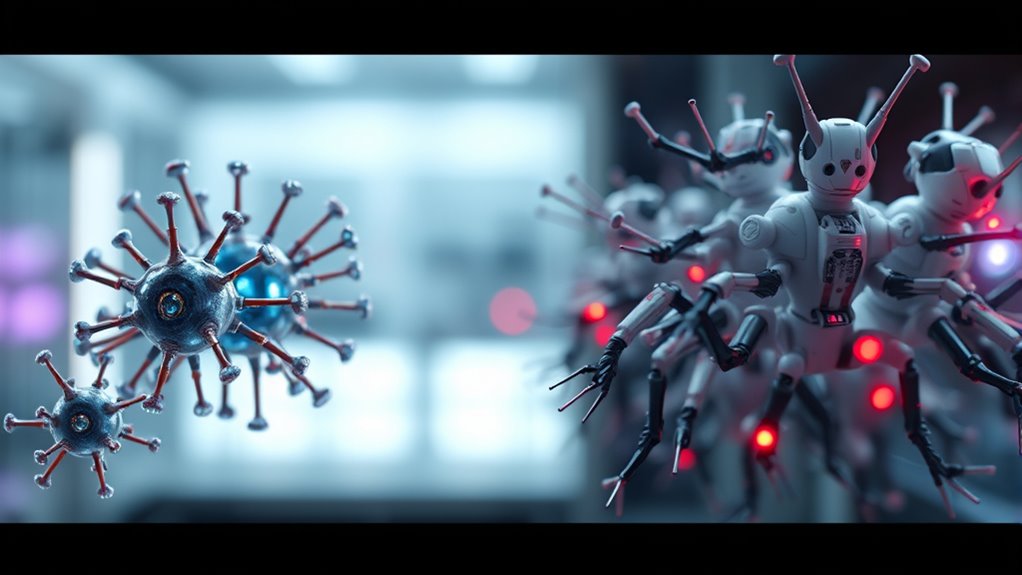
Have you ever wondered how tiny machines could revolutionize medicine? Nanomachines and micromachines open new frontiers in diagnosis and treatment. They can target specific cells, deliver drugs precisely where needed, and perform minimally invasive procedures. For example, nanomachines could navigate through bloodstreams to detect early signs of diseases like cancer, providing real-time data. Micromachines might be used to clear clogged arteries or repair tissues directly inside the body. These devices offer faster, more accurate interventions with fewer side effects compared to traditional methods. Their ability to operate on such a small scale allows for unprecedented access to hard-to-reach areas, making treatments safer and more efficient. As technology advances, these tiny machines could become essential tools in personalized medicine and preventative healthcare. Additionally, ongoing research aims to improve operational capabilities and integration with existing medical systems to maximize their potential benefits.
Manufacturing and Industrial Uses

Manufacturing and industrial sectors are increasingly turning to nanomachines and micromachines to enhance precision and efficiency. These tiny devices enable you to perform tasks at a molecular or microscopic level, reducing waste and improving quality. You can use nanomachines for assembling complex electronic components, ensuring atomic-level accuracy. Micromachines facilitate rapid, automated inspection processes, catching defects early. Additionally, these technologies allow for precise material manipulation, such as targeted drug delivery in pharmaceutical manufacturing or advanced material synthesis. They also support the development of smart materials that respond to environmental stimuli. This integration leads to streamlined production lines, cost savings, and higher product reliability. As these miniature machines evolve, expect even more innovative applications across diverse manufacturing sectors, transforming traditional processes into highly sophisticated, automated systems.
Environmental Monitoring and Remediation

Nanomachines and micromachines are revolutionizing environmental monitoring and remediation by providing precise, on-site analysis and targeted cleanup capabilities. You can deploy these tiny devices directly into polluted water, soil, or air to detect contaminants at molecular levels. Their small size allows you to access hard-to-reach areas, ensuring thorough assessments. During remediation, they can identify pollutants, catalyze breakdown processes, or physically remove hazardous substances. This targeted approach minimizes disruption to the environment and reduces the need for large-scale machinery. With their real-time data collection, you gain immediate insights, enabling swift responses to environmental hazards. Their small size and advanced capabilities also allow for remote operation, enhancing safety and efficiency in hazardous conditions. Overall, these nanoscopic and microscopic tools enhance your ability to protect ecosystems more effectively and efficiently than traditional methods.
Future Prospects and Technological Advances
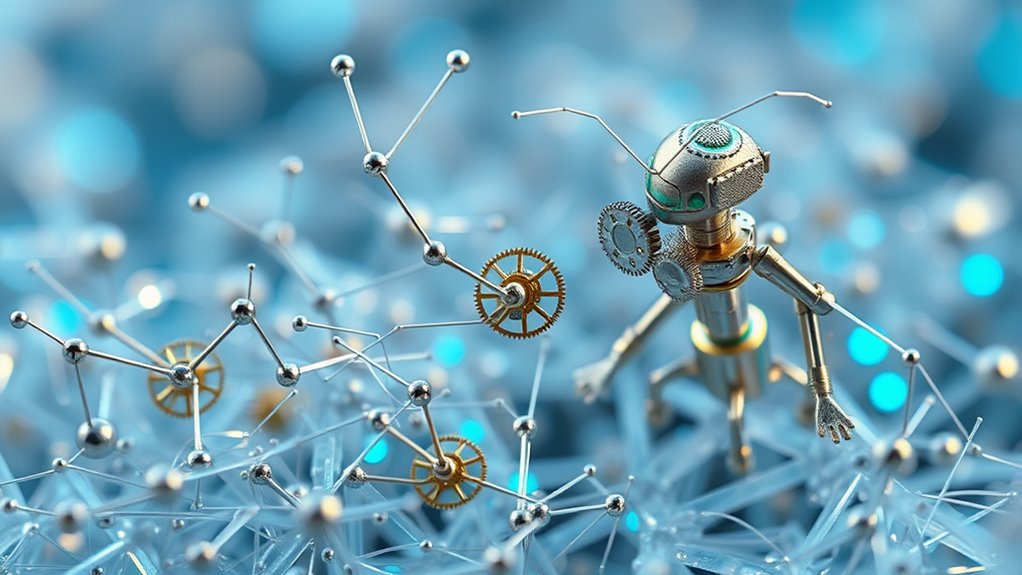
Advancements in nanotechnology and microfabrication are rapidly expanding the capabilities of nanomachines and micromachines, opening exciting possibilities for environmental applications. You can expect these technologies to revolutionize pollution detection, targeted remediation, and resource management. Breakthroughs in materials science will enable more durable, biocompatible, and efficient devices. Integration of artificial intelligence and machine learning will improve autonomous operation and data analysis, making machines smarter and more adaptable. Additionally, scalable manufacturing processes will reduce costs and facilitate widespread deployment. As these innovations progress, you’ll see an increase in precision, functionality, and versatility, paving the way for complex tasks previously thought impossible at such small scales. The future promises a seamless blend of robotics, biology, and chemistry, transforming environmental solutions.
Ethical and Safety Considerations
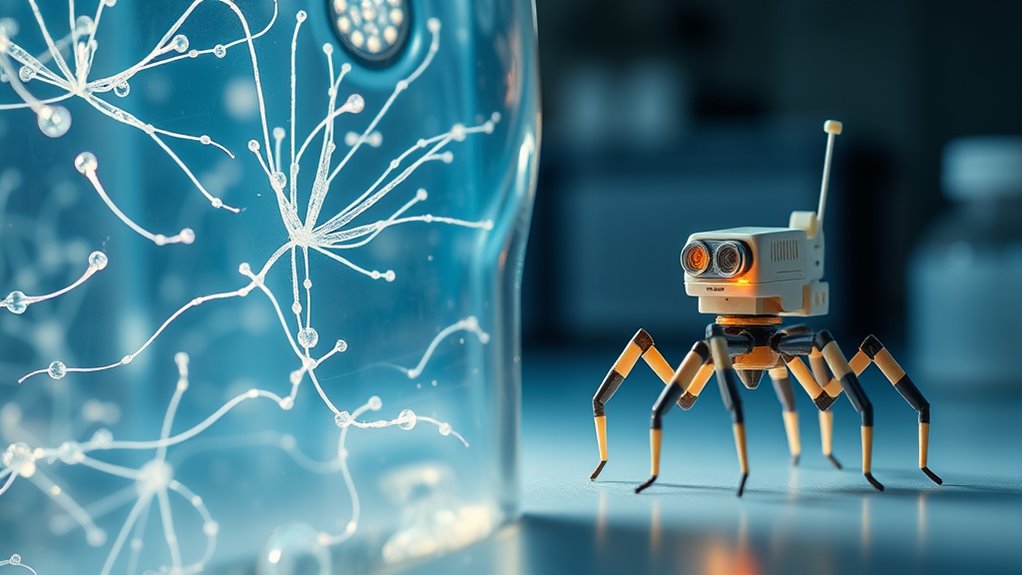
As nanomachines and micromachines become more integrated into environmental solutions, addressing their ethical and safety concerns is crucial. You must consider the potential risks of unintended consequences, such as ecological disruption or bioaccumulation. Safety protocols are essential to prevent accidents during manufacturing, deployment, and disposal. Ethical questions also arise around privacy, consent, and control, especially if these devices monitor or influence living organisms. Regulations and international standards are necessary to guarantee responsible development and use. You should prioritize transparency and public engagement to build trust. Balancing innovation with caution safeguards both the environment and society. Ultimately, proactive measures will help prevent misuse and ensure these technologies serve humanity positively.
Frequently Asked Questions
How Do Nanomachines and Micromachines Communicate Within Complex Systems?
You enable nanomachines and micromachines to communicate within complex systems through various methods like wireless signals, chemical exchanges, or electromagnetic fields. You design them to send and receive data efficiently, often using tiny antennas or sensors. By programming their responses and protocols, you guarantee seamless coordination. This communication allows these machines to work together in tasks like targeted drug delivery or environmental monitoring, enhancing their effectiveness in complex environments.
What Are the Energy Sources Powering Nanomachines Versus Micromachines?
You might think nanomachines run on tiny batteries, but they often use environmental energy like heat, light, or chemical reactions—talk about making do! Micromachines, being bigger, usually rely on more traditional power sources like small electric or combustion engines. So, while nanomachines squeeze energy from their surroundings, micromachines get to enjoy batteries or fuel, proving size does matter when it comes to powering up.
How Do Environmental Factors Affect Nanomachines’ and Micromachines’ Performance?
Environmental factors critically influence both nanomachines and micromachines. You’ll find that temperature fluctuations can alter their efficiency, with nanomachines being especially sensitive due to their tiny scale. Humidity and chemical presence may cause corrosion or malfunction, while physical obstructions can hinder movement. You need to carefully consider these factors during design and deployment to guarantee ideal performance and longevity for your devices in real-world conditions.
Are There Differences in Maintenance or Repair Needs at These Scales?
Imagine you’re fixing a tiny robot with a Swiss Army knife, just like in old spy movies. At these scales, maintenance and repairs differ profoundly. Nanomachines often require specialized tools or chemical treatments due to their size, while micromachines can sometimes be repaired using microscopic tools or localized energy sources. You need to understand their specific environments because dust, temperature, or chemical exposure can impact how often they need repairs.
What Are the Economic Impacts of Deploying Nanomachines Compared to Micromachines?
Deploying nanomachines typically lowers costs over time because they require less material and energy, and can perform precise repairs or manufacturing at a microscopic level. Micromachines, while easier to develop and maintain now, can be more expensive long-term due to larger size and higher resource needs. You’ll see economic benefits from nanomachines through efficiency, reduced waste, and new market opportunities, but initial investments might be higher.
Conclusion
As you explore nanomachines and micromachines, it’s fascinating to see how their tiny sizes unleash huge potential. Did you know that nanomachines can operate at the atomic level, enabling precise drug delivery? With ongoing innovations, these devices could revolutionize medicine, industry, and environmental care. Staying aware of ethical concerns guarantees responsible development. Embrace the future of these tiny titans—your understanding could shape the next big breakthrough in technology.


